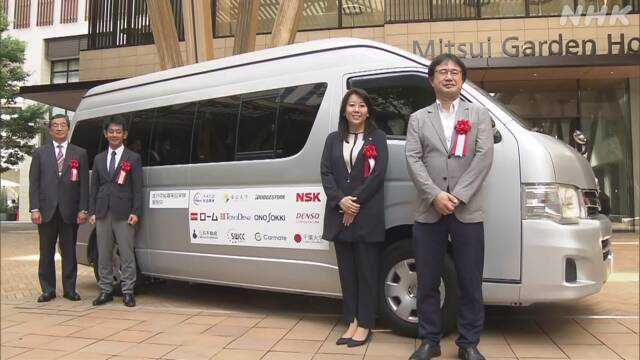As the spread of EVs = electric vehicles becomes an issue for the realization of a "decarbonized society", a demonstration experiment on public roads for the first time in Japan with the latest technology that can be charged while driving will begin in Kashiwa City, and a commemorative ceremony was held on the 3rd.
This technology is being jointly researched by the University of Tokyo, major auto parts manufacturers, major real estate companies, and others, and at a ceremony held in Kashiwa City, two EVs running on public roads were unveiled as an experiment.
In all cars, a conductor coil is attached under the car body, and electricity is received from another coil embedded under the road through an "electromagnetic induction" mechanism that can be charged while driving.
Until now, experiments have been conducted on the university campus, but with the cooperation of the city, coils that transmit electricity will be embedded at the intersection of the city road in front of the Tsukuba Express Kashiwanoha Campus Station, and the first demonstration experiment on a public road in Japan will be realized.
From March 4, we will conduct a full-scale driving test to confirm the extent to which the battery can be charged until March of next year.
At the ceremony, Kashiwa City Mayor Kazumi Ota said, "This technology will lead to weight reduction of batteries in the future, and I hope that it will be put to practical use in the future."
Professor Hiroshi Fujimoto of the University of Tokyo, a member of the research team, said, "Future experiments will be important for practical use, and although it may sound like a dream, we would like to develop the technology in cooperation with companies and others."
"Charging while driving"
"Charging while driving" utilizes a mechanism of "electromagnetic induction" that generates an electric current when the magnetic force passing through the coil of the conductor changes.
When an electric current is applied to a coil embedded in the ground, a magnetic force is generated in the surrounding area.
When another coil attached to the EV overlaps this, a current is generated in this coil due to the influence of magnetic force.
Electricity can be sent even if the wires are not directly connected, and this mechanism is also used for wireless charging of smartphones.
Professor Hiroshi Fujimoto of the University of Tokyo has been working on research on "charging while driving" in collaboration with private companies for the past 10 years, and has been conducting experiments on campus.
With the current device, if the coils on the power transmission side and the power receiving side overlap for 1 second, it can charge enough to drive about 100 meters, and if they overlap for 10 seconds, it can charge about 1 kg.
The challenge is the cost of embedding the coils in the roads, and Professor Fujimoto believes that it is realistic to introduce them from buses that run on a fixed route every day, and after this experiment, he would like to conduct experiments on routes around campus.
Professor Fujimoto aims to put this technology into practical use around 2030, saying, "If 'charging while driving' spreads, it will be easier to purchase EVs even if there are no charging facilities. We want many people to be able to enjoy our services in the future."
Expectations for future practical application of "charging while driving"
Operators who have introduced EVs are expecting the future practical application of "charging while driving."
Heiwa Kotsu, which operates buses in Chiba Prefecture, has introduced two large buses and one small bus that run on batteries and motors, and operates them on route buses in Chiba City.
By introducing electric buses, this company has been able to reduce the cost of operation by about 2% for large buses and 1% for small buses, because it is not necessary to use diesel fuel, which is soaring compared to electricity bills, and there is no need to change the engine oil of vehicles.
On the other hand, the challenge is charging, which is done after the end of the daily operation by setting up three charging stations in the garage, but due to the large capacity of the battery, it takes more than 3 hours to fully charge.
The company wants to increase the number of electric buses in the future, but at present, it is necessary to add stands by the number of electric buses, which is a bottleneck.
If "charging while driving" is put into practical use, we expect that the charging environment will be improved and that it will be easier to introduce it on routes connecting Narita Airport and other airports with long mileage.
Hirotaka Fujiwara, general affairs manager of Heiwa Kotsu, said, "The cost reduction effect of the introduction of electric buses exceeded expectations.
Expert "big step"
Experts familiar with electric vehicles say that although the development of "charging while driving" has been delayed Japan overseas companies, this test on public roads is "a big step."
Kaori Takahashi, Senior Researcher of the Mobility Strategy Group, Mitsubishi Research Institute, said, "Even if universities and companies want to conduct experiments on public roads, cooperation with road managers and the government is necessary, but it is very meaningful because it can be understood and demonstrated, and the data obtained this time is very valuable."
On the other hand, the development of "charging while driving" is accelerating, mainly in Europe and the United States, where the spread of EVs is spreading, and Israeli companies are conducting demonstrations under various conditions such as long driving and high-speed driving, and the competition for practical application is intensifying worldwide.
In Japan, in addition to Kashiwa City, demonstration tests of bus charging are scheduled to be conducted at the venue of the Osaka-Kansai Expo next year, and Mr. Takahashi said, "This demonstration experiment will be a big step for Japan to advance technological development Japan. I pointed out.

